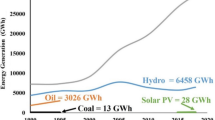Abstract
A political agreement from 2005 stated that an evaluation of the entire Danish energy efficiency policy portfolio must be carried out before the end of 2008, with the aim to assess the following: (1) Is the policy portfolio sufficient to meet the energy efficiency targets? (2) Do the policies enable the national goals to be met in a cost-effective manner? (3) Is the overall design of the policy portfolio appropriate? The evaluation gave recommendations on how to improve and develop the portfolio, mainly using cost-effectiveness as criteria. The evaluation was completed in December 2008, and this paper presents the main findings and the subsequent impact on Danish policy. A key lesson learned is the importance of including all energy efficiency policies in the evaluation. Examining the entire portfolio of policies (as opposed to only selected policies) gave way to findings that would otherwise not have been captured. With its broad perspective, the evaluation found that the policy instruments prioritised the commercial and industrial sectors less than the household and public sectors. The recommendations made by the authors contributed to the implementation of new taxes for the commercial and industrial sectors together with the reform of the Electricity Saving Trust to a Centre for Energy Savings charged with energy savings within all sectors, except transport—both which have been important steps towards a more cost-effective solution.


Similar content being viewed by others
References
Aggerholm, S. (2008). Energy frames for the buildings of the future—Theme day on reduction of the energy consumption in buildings (Energirammer for fremtidens bygninger. Temadag om reduktion af energiforbruget i bygninger) Statens Byggeforskningsinstitut (SBi).
Catinét Research (2008). Evaluation of the projects of the energy saving fund 2005–2007 (Energisparepuljens projekter fra 2005–2007. Samlet evaluering).
Consultation Document (2008). Consultation document on the revision of the Energy Labelling Directive 92/75/EEC of 22 September 1992 on the indication by labelling and standard product information of the consumption of energy and other resources by household appliances. Working Document presented by the Directorate General for Energy and Transport, European Commission.
Danish Economic Councils (2010). Economy and Environment—annual report 2010. Danish Economic Councils.
Ea Energianalyse, Niras, RUC, 4-Fact (2008). A way to higher energy efficiency. Evaluation of all Danish energy efficiency activities (En vej til flere og billigere energibesparelser—Evaluering af samtlige danske energispareaktiviteter). Copenhagen: Ea Energianalyse, Niras, RUC, 4-Fact
ESD (2006). Directive 2006/32/EC of the European Parliament and the Council of 5 April 2006 on energy end-use efficiency and energy services. European Commission
EU NEEAP Assessment (2009). Synthesis of the complete assessment of all 27 National Energy Efficiency Action Plans as required by the EU Directive 2006/32/EC on energy end-use efficiency and energy services, SEC(2009)889 final. European Union.
Kjærbye, V.H. (2008). Does energy labelling on residential housing result in energy savings? Anvendt Kommunal Forskning (AKF).
Kjærbye, V.H., Larsen, A.E., Togeby, M. (2010). The effect of building regulations on energy consumption in single-family houses in Denmark. Ea Energy Analyses.
Larsen, A., Leth-Petersen, S., Kjærbye, V. H., & Rieper, O. (2006). The effect of energy audits in Danish industry—Evaluation of a DSM programme. Energy Studies Review, 14(2), 30–41.
Ministry of Climate and Energy (2009). Agreement about the future energy efficiency activities. (Aftale af 20. november 2009 mellem klima- og energiministeren og net- og distributionsselskaberne inden for el, naturgas, fjernvarme og olie repræsenteret ved Dansk Energi, Dansk Fjernvarme, Foreningen Danske Kraftvarmeværker, HNG/Naturgas Midt-Nord, DONG Energy, Naturgas Fyn samt Energi- og Olieforum om selskabernes fremtidige energispareindsats.) Ministry of Climate and Energy.
Ministry of Transport and Energy (2006). Agreement of August 22, 2006 between the Transport and Energy Minister and the network and distribution companies within electricity, natural gas, and oil. (Aftale af 22. august 2006 mellem transport- og energiministeren og net- og distributionsselskaberne inden for el, naturgas og olie repræsenteret ved Dansk Energi Net, HNG og Naturgas Midt-Nord, DONG, Naturgas Fyn og Oliebranchens Fællesrepræsentation om selskabernes fremtidige energispareindsats). Copenhagen: Ministry of Transport and Energy.
SOU. (2008). The road to a more energy efficient Sweden (Vägen till ett energieffektivare Sverige. Slutbetänkande av Energieffektiviserings-utredningen) (p. 110). Statens Offentliga Udredningar.
Økonomi- og Erhvervsministeriet. (2008). Growth, climate, and competitiveness (Vækst, klima og konkurrenceevne). Økonomi- og Erhvervsministeriet.
Author information
Authors and Affiliations
Corresponding author
Rights and permissions
About this article
Cite this article
Togeby, M., Dyhr-Mikkelsen, K., Larsen, A.E. et al. A Danish case: portfolio evaluation and its impact on energy efficiency policy. Energy Efficiency 5, 37–49 (2012). https://doi.org/10.1007/s12053-011-9117-7
Received:
Accepted:
Published:
Issue Date:
DOI: https://doi.org/10.1007/s12053-011-9117-7




